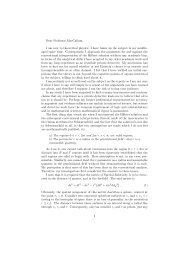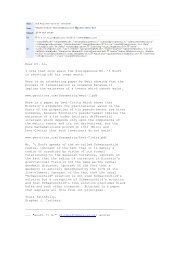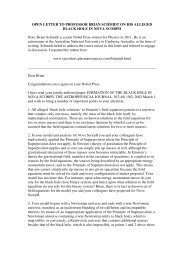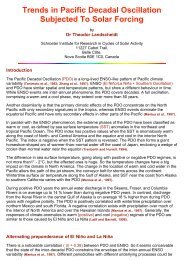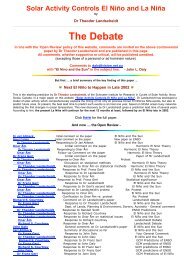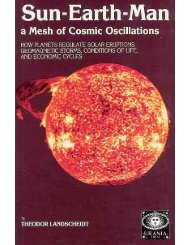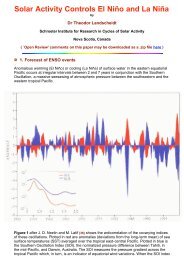THEODOR LANDSCHEIDT - The Golden Section - PlasmaResources
THEODOR LANDSCHEIDT - The Golden Section - PlasmaResources
THEODOR LANDSCHEIDT - The Golden Section - PlasmaResources
You also want an ePaper? Increase the reach of your titles
YUMPU automatically turns print PDFs into web optimized ePapers that Google loves.
technique of running means over two, three, or more consecutive readings with equal or different weights is applied<br />
to variance, the square of the standard deviation.<br />
Figure 6 presents the 36-year running variance v of the sun's orbital angular momentum for the years 700 to 1600.<br />
It solves the problem of how to forecast periods of weak solar activity and colder climate. Arrows mark the observed<br />
epochs of Gleissberg minima assessed by Gleissberg (1958) and Link (1978). All these minima coincide with distinct<br />
extrema in the 36-year running variance of the sun's angular momentum. This is also true for the following centuries.<br />
According to my calculations, the next minimum in the 90-year sunspot cycle —half of a "big hand" cycle of 180<br />
years—is expected about the year 2026. Indications are that a grand minimum of the Maunder Minimum type and a<br />
new Little Ice Age comparable to that of the seventeenth century may occur then (Landscheidt 1990b). Recent results<br />
of climatologists show that the greenhouse effect cannot eliminate this development (Ramanathan et al. 1989;<br />
Beardsley 1989; Meier 1990; Kiehl 1991).<br />
Certain quantum field theories have demonstrated that renormaliza-tion transformations involving a change of scale<br />
can be a useful research tool. Nobel Prize recipient K.G. Wilson displayed that this principle can be applied<br />
universally. If you are stalled in your research, choose a coarser or finer scale.<br />
FIGURE 5. <strong>The</strong> sun's oscillations about the solar system's center of mass, 1945-1995. Shown are celestial positions of<br />
the solar system's center of mass (small circles) relative to the sun's center (cross). <strong>The</strong> large heavy circle describes<br />
the sun's surface. <strong>The</strong> center of mass and the sun's center can come close together, as in 1951 and 1990, or reach a<br />
distance of more than two solar radii. Between these two extremes, the sun's orbital angular momentum can increase<br />
or decrease forty-fold.<br />
FIGURE 6. 36-year running variance in the sun's orbital angular momentum, 700 to1600. All extrema coincide with



